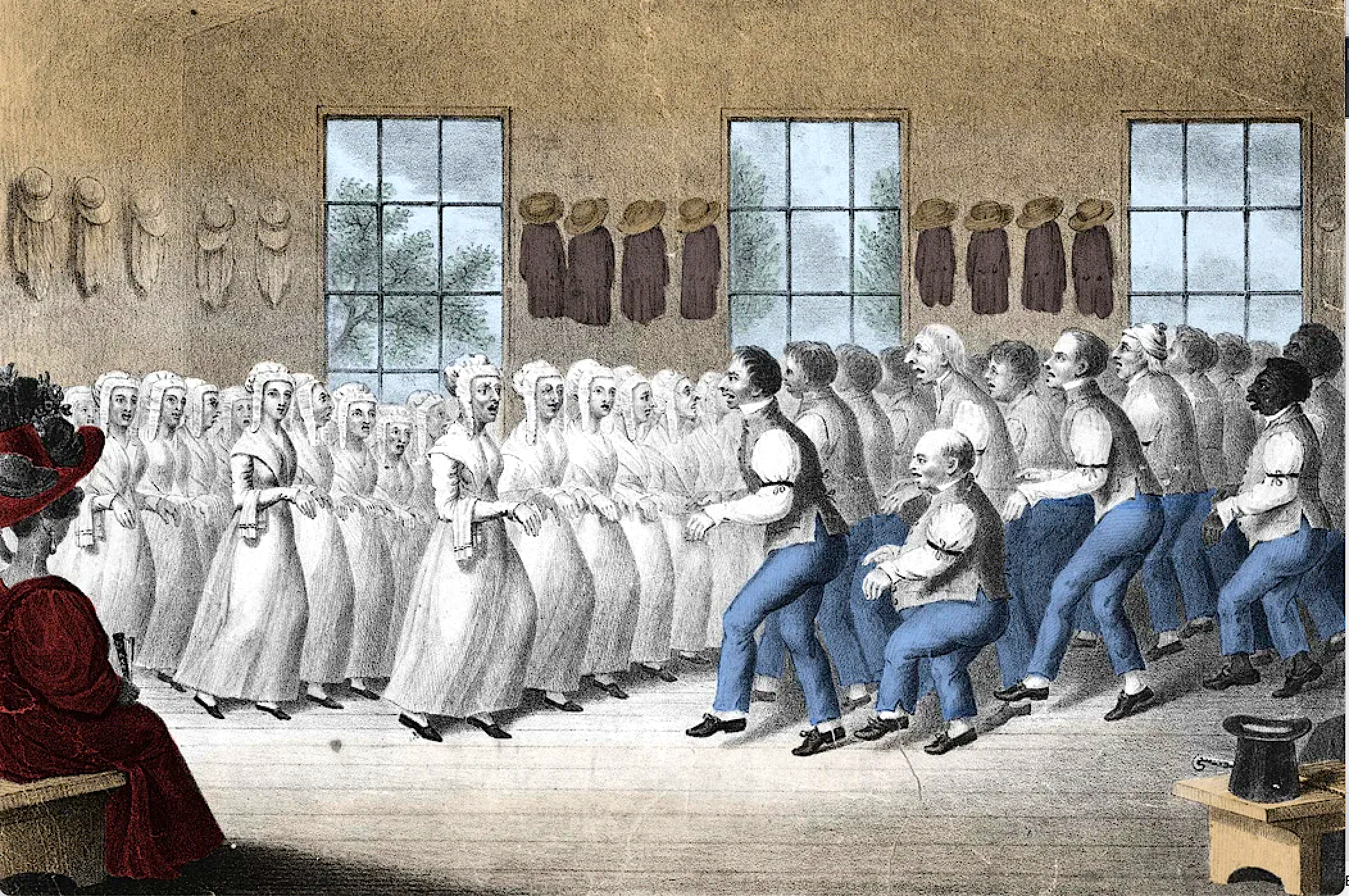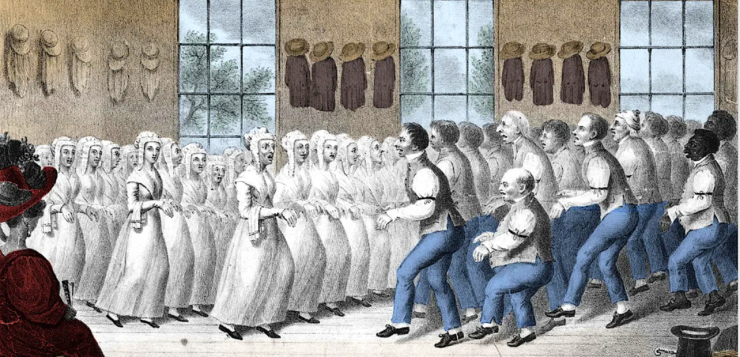ADAM AND EVE APPEARED to a woman named Ann Lee in Manchester, England, in 1770. An unhappily married woman who had endured the deaths all four of her infant children, Lee had been following various fringe religious movements when the biblical couple suddenly materialized before her—not eating of the forbidden fruit as might be expected, but instead engaging in sweaty, grunting, grappling coitus. Lee was thoroughly disgusted. Her disturbing vision would lead her to America, where she founded one of the major religious sects of the late 18th and early 19th centuries, one that held as its primary tenet that all sex of any kind—whether in marriage or not, for reproduction or mere pleasure, with another or alone—was bestial and degrading and vile.
As the barrier of the Appalachians toppled and the country spilled westward toward the plains, many Americans found the absence of geographic limits disorienting, and they searched for ways to safely circumscribe their personal world. In matters religious, this often meant turning to faith communities with clear and strict regulations, authoritarian structures with inflexible rules not open to interpretation. In a world that seemed increasingly scattershot, America’s new religions offered order and discipline. For members of Ann Lee’s United Society of Believers, popularly known as the Shakers, the requirement of celibacy promised a welcome release from the messiness of sex.
The Shakers offered a particularly attractive alternative for women. As a religion founded by a woman, it insisted on the equality of the sexes. Lee proclaimed herself the second coming of Jesus Christ, this time in a female body, and taught that God was both male and female. She insisted on gender parity in the governance of Shaker villages and encouraged women to speak their minds. In her communities, men and women would live parallel but partitioned lives, with many buildings designed to have separate entrances and separate staircases to minimize intermingling of the sexes. Labor was strictly divided along gender lines, and while “women’s work” of sewing, washing, cleaning, and cooking was arduous and unending, the heavy labor of planting, harvesting, and construction was handled by the men. Unlike in female-only communities, Shaker women could confine themselves to the traditional “feminine sphere” of work, enjoying a close, supportive sisterhood while still receiving all the benefits of having a man around the house—without the pesky demands for sex. And in a world where infant mortality and death in childbirth were tragically common, deciding to avoid heterosexual sex could be a life-saving choice for a woman.

For men, the benefits of entering a celibate community are less clear—unless the men were reluctant to engage in vaginal sex in the first place. Some Shaker men could not separate the idea of sex from sin and were willing to live apart from their wives in return for the promise of a heavenly reward. For men who felt little or no desire for women, however, the Shaker life offered the opportunity to live in a community where interaction with females would be only intermittent, and highly regulated. Instead, they would live in intimate communion with other men, fellow seekers who had taken a solemn vow to keep their sexual desires in check. Constant temptation, but temptation corralled behind iron gates of religious resolve.
Unfortunately, our understanding of the early years of the sect is handicapped by warped sources. Ann Lee herself was completely illiterate, and she established as the first rule of Shaker life that you don’t write about Shaker life. Maintaining a strictly oral tradition provided some protection against a hostile response to their controversial beliefs and practices. As a result, documentation about the early period comes mostly from prejudiced outsiders, and from apostates who once professed belief but eventually left the order. The hostile screeds of outsiders can be discounted, but many of the apostate writers produced nuanced accounts of their time among the Shakers, being careful to correct the misrepresentations of outsiders, acknowledging the admirable traits that drew them to the communities in the first place, but writing unsparingly of practices that drove them to leave.
From a somewhat sympathetic Daniel Rathbun we learn that Mother Lee required her followers to strip naked and engage in wild, ecstatic dancing in imitation of the innocence of Adam and Eve before the Fall, after which she would beat the believers’ genitals to punish any postlapsarian randiness. “[T]he mother’s pounding and beating the private parts of both men and women in her discipline—these things have I seen,” Rathbun wrote. Abuse of one’s genitals became an accepted rite, with members believing that they could exhaust their sexual desire through strenuous exertion. These exercises were particularly painful and debilitating for the men. Reuben Rathbun, Daniel’s nephew, reported that “in a short time they who were the most zealous and faithful labored into that degree of mortification that the natural functions of the body were so impaired, and the power of retention so relaxed that they were not able to keep themselves from involuntary evacuations [i.e., ejaculations], almost continually, which made some almost despair of ever being saved, as the natural seed of copulation was looked upon as the most unclean and hateful of any thing in the natural creation.” The men beat on, “but still the flesh lived, though some were so violent in their labors, and brought their bodies under so much weakness that there was not much power of erection in the parts of generation.”
But it was not all liturgical jerks. To sympathetic outsiders, Shaker communities appeared to be the epitome of utopian harmony. Their buildings were sturdy and practical. Their grounds were immaculate. Their farms employed advanced agricultural techniques, and many were enviably profitable. The functionality and workmanship of Shaker furniture made it highly desirable. Visitors were invited to observe selected religious services, where they saw, not wild bacchanals, but regimented dances with the women on one side of the room and the men on the other. Participants danced intricate patterns in lockstep, like automatons with blissful smiles upon their faces, singing of the joys of being simple.
Reality was a bit more complex. Shaker communities were roiled by the requirement of celibacy, the practice singled out above all others as “bearing the cross.” Whether the issue was unruly lust or just the basic need for emotional intimacy with another individual, it was a hard cross to bear for many believers. Shaker life rubbed against the grain of human longing, presenting a challenge that many found impossible to meet, and difficulty with celibacy was the major reason for desertions from the order. Moreover, at the heart of its theology was an unresolvable conflict. Shaker daily life was built around a binary conception of gender. Being a good Shaker meant knowing which door you should enter, which staircase you should descend. And yet, the ultimate goal that Mother Ann taught was to become like God: both male and female. For most Shaker men and women, this meant stifling one’s attraction to the opposite sex in order to become both in oneself. For women who desired women, and for men who desired men, the conflict became unbearably complicated.
As the 19th century progressed, new converts to the religion attempted to disentangle the rumors they had heard about the Shakers from the theology that was now being preached. For many, the question of naked dancing was a particular stumbling block because it seemed so obviously sexual. Thomas Brown questioned Elder Hezekiah Rowley on that point, and though Rowley at first repeatedly denied that naked dancing ever occurred, he eventually admitted that years ago, during the time of Mother Ann Lee, such events did take place. He related to Brown an incident that included Lee’s own brother William (an amateur boxer described by one former Shaker as “a man of great personal beauty”). Recalled Rowley:
One day, in the afternoon, William Lee, having drank very freely, fell asleep; when he awoke, he ordered the brethren (in number about twenty) to be assembled, I being one with them. William Lee then informed us, that he had a gift [i.e., a divine revelation] to rejoice—and ordered us to strip ourselves naked; and as we stood ready to dance, Mother Ann Lee came to the door of the room with one of the sisters. William Lee requested her to stay out, as he had a gift to rejoice with the brethren. Still she persisted. He said to her again, Mother, do go out—I have got a gift to rejoice with the brethren; and why can’t you let us rejoice? you know if any of the sisters are with us, we shall have war, that is, have to fight against the rising of nature.
Ann Lee refused to go away, eventually attempting to climb in through a window. The confrontation with her brother turned physical: “I immediately stepped in between them, and cried out, for God’s sake, Father William, don’t strike Mother! I had rather you would strike me. The brethren, who had stood [naked]waiting the event, then gathered round and prevented further blows. There was a hard threatening on both sides. Thus ended the gift of rejoicing.”
The Shakers’ sexual theology did not remain static, and after the death of Ann Lee in 1784, it began to incorporate some of the beliefs of the general American public, especially the concept of “spermatic economy.” In this conception of human sexuality, men are physically diminished with every ejaculation. Masturbation was seen as the major culprit leading to masculine enfeeblement, but women bore a large share of the blame. Despite being a religion founded by a woman, and one based on the principle of the equality of the sexes, the Shakers could not resist the corrosive force of misogyny in American culture. In time, women were portrayed as lustful Jezebels bent on luring innocent men to their doom. When, in 1819, Joel Wood and Clarissa Cogswell fled their Shaker community in the middle of the night, the elders were glad to get rid of Clarissa, for “she was never a good Believer—she was considered a very disorderly, insinuating witch of a woman and proved to be Joel’s ruin.” Joel, on the other hand, they would miss.
The Shakers saw their strict separation of the genders as a path to salvation for weak-willed men, and as an aid to women to control their unruly concupiscence. A man who gave in to his sexual desires was labeled as “effeminate,” as he was taking on the characteristics of a lustful female. Outsiders who opposed the Shakers were denounced as “boogers [buggers], devils and Sodomites.” The entire structure of Shaker belief system rested on the suppression of sexual desire, and homosexuals—who engaged in sex that was doubly forbidden—were doubly damned.
Still, there were queer Shakers. Rebecca Cox Jackson, a free woman of color, and her partner Rebecca Perot were active in the Shaker community at Watervliet, New York, and later in Philadelphia. When Thomas Munson and Alexander McArthur left the Mount Lebanon Shakers in 1837, Munson was denounced as an unfaithful “cross-bearer” and McArthur as a “cider toper [drunkard]& corrupter of the simple.” In his journal (some of which is written in a private code), Shaker Isaac Newton Youngs denounced Munson as a “fleshmonger” and recorded his distress on learning that Munson and McArthur were “very much married together.”
Most homosexual desire, however, was ultimately sublimated into what the Shaker elders denounced as “special love”—intimate feelings directed toward a particular individual rather than a shared affection for the entire community. Such attachments—even though they were not overtly sexual—were rooted out whenever they were discovered, so same-sex couples needed to keep their special love a secret. In an 1853 memoir about his fifteen years spent among the Shakers, Hervey Elkins wrote of his particular friendship with Francis Lupier. “[T]he intimacy between Francis and myself soon became so strong, that each felt the indispensability of the other’s society. This intimacy was soon transformed into an almost indissoluble tie of friendship. We felt ourselves one in spirit, reciprocally blended like two diverse atoms, in nature, by chemical affinity, and which by the combination are transformed into a substance unlike either of the separate elements.” But the young men needed to keep their love hidden. Wrote Elkins:
For who could tell … subjected to that regime which has for its object the dissolution of the most powerful affections of our nature, how long we should be permitted to thus enjoy each other’s society—a love which had already become as powerful as our religious enthusiasm. It was now that I first began to dread that system of religion to which I had been so attached. For it separates warm and ardent friends;—and I now had a friend, of near my own age, from whom I could not bear the idea of being separated. This love was not universal, therefore it was not owned.
The young couple eventually parted and lost contact with one another, but years later, in his book about the Shakers, Elkins included a touching message to his lost friend: “Francis has since left the Society; and should a copy of this little recital fall into his hands, he will recognize these truthful statements, and, we hope, address a letter to his quondam friend and brother. —Hervey Elkins, Hanover, N. H.” For Elkins, it was like a note in a bottle tossed into the sea, with the hope that Lupier, wherever he might now be, would discover the book, read the passage, and know that his special love was still strong.
References
Goodwillie, Christian, ed. Writings of Shaker Apostates and Anti-Shakers, 1782-1850. Routledge, 2013.
Kern, Louis J. An Ordered Love: Sex Roles and Sexuality in Victorian Utopias. Univ. of North Carolina Press, 1981.
Stein, Stephen J. The Shaker Experience in America. Yale Univ. Press, 1994.
Wergland, Glendyne R. One Shaker Life: Isaac Newton Youngs, 1793-1865. Univ. of Massachusetts Press, 2006.
William Benemann is the author of Unruly Desires: American Sailors and Homosexualities in the Age of Sail and Men in Eden: William Drummond Stewart and Same-Sex Desire in the Rocky Mountain Fur Trade.





